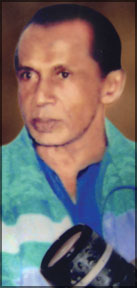|
K.G. Gunaratne :
His interests are wide and varied
 In the south west coast of Colombo, 53 miles away lies the town of
Ambalangoda. It is an important fisheries centre. The anthropologist
will find no better region in which to study or merely observe the
exorcist ‘Devil dancers’ of the island, while it is also the home of the
Sinhala mask called ‘Kolam'. In the south west coast of Colombo, 53 miles away lies the town of
Ambalangoda. It is an important fisheries centre. The anthropologist
will find no better region in which to study or merely observe the
exorcist ‘Devil dancers’ of the island, while it is also the home of the
Sinhala mask called ‘Kolam'.
Mask carving is still a lively tradition in Ambalangoda. The reputed
drummers and Vesak pandal painters emerge from Ambalangoda. About 1 ½
miles away from the town, the road leads to a remote village,
Keraminiya. The village is a natural fertile valley with smiling
luscious green paddy fields, shaded by coconut trees.
It is in this village of Keraminiya that K.G. Gunaratne was born on
September 12, 1936. As a child he showed qualities of a budding artist,
and scribbled images of human figures, birds and animals on the walls of
his home with charcoal or chalk, and on paper. He had his first
schooling at Polwatta Boys’ School and later at Dharmasoka College,
Ambalangoda. He did not inherit any skills from his ancestors, but from
an early age he came under the tutelage of a prominent art teacher in
the district of Ambalangoda, M.W. Lairis Silva and later under reputed
teachers such as Benard Lokuge, Bandula Fernando and S.M. Somadasa of
Dharmasoka College, Ambalangoda. While a schoolboy he grabbed the
college senior art prizes at the annual prize givings and took part in
exhibitions organised by the Ambalangoda Society of Arts where he won
many awards.
 |
|
K.G. Gunaratne |
 |
|
One of his paintings |
His paintings have attracted and fascinated the attention of many art
lovers not only in Sri Lanka, but many foreigners as well who visit his
mini art gallery at his home. The paintings have great quality.
Gunaratne continues to paint on oil on canvas and acrylic pictures of
human character giving more prominence to line. His subject matter,
mostly the human figure, is especially women. The wide range of subjects
such as ‘The flute player’, ‘Homeward bound’, ‘The Veena Player’ each
painting treated with such profuse detail and intensity and are very
much his own technique and style absorbed over the years to evoke his
own society. His paintings are beautiful in which much of the subject is
described by sharp, precise lines, endorsing sober monochrome washes.
Having received an honours certificate in art from the Royal Drawing
Society of London he rolls along challenging and disputing the old
saying, rolling stones gather no moss, because Gunaratne through the
changes in his life, spanning many decades, has gathered a great deal of
invaluable moss. His first appointment as an art teacher was at
Dharmakusala Maha Vidyalaya, Ambalangoda.
He passed on his skills to several generation of students at the
school. He organised arts and crafts exhibitions and encouraged the
young students to exhibit brilliant creations.
The year 1956 was a significant one when one of his paintings was
selected from an art competition organised by the Ambalangoda Society of
Arts, to be sent to the Russian museum as a permanent collection. In
addition to being a painter Gunaratne's interests varied. He was more
concerned with the magic box (the camera) where he would spend hours
visiting sights to capture the wild freshness of the mountains, the
glories of nature.
In 1965 he entered the Heywood College of Fine Arts (known then) and
obtained the Diploma Certificate in Photography. In 1971 he entered the
Training School at the Sri Lanka Broadcasting Corporation and obtained a
Proficiency Certificate in Mass Media and later worked as an official
photographer and artist.
He has also worked as a Public Relations Assistant and Publicity
Officer in the private sector.
Gunaratne has also gained reputation as a writer and published a book
named Jeevithayta Alokayak. Though he is widely known as ‘KG’ among his
contemporaries, one can suffix another ‘G’ to his name meaning genius.
|



